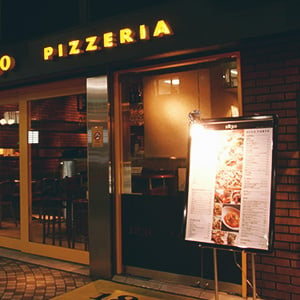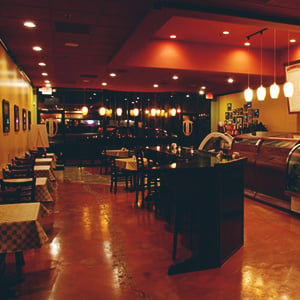
Pizza shops are one of the most popular types of foodservice establishments in the country. They can be found in countless towns and are often a staple of local culture, with many geographical regions even having types of pizza that are unique to them. Whether you're new to the pizza industry or have worked in it for years, opening a pizzeria can be a great investment. We'll walk you through the steps of starting a pizza shop so that you can position your business for success.
Shop All Pizza Shop Supplies and Equipment1. Write a Pizza Shop Business Plan
A business plan acts as the roadmap for how to get your pizza shop off the ground. It outlines many details, including short- and long-term goals, financial projections, and market analysis. With a good business plan, you can stay focused on your objectives and make informed decisions as your business grows.
Business plans are also extremely valuable when securing funding. Lenders and investors want a well-thought-out plan demonstrating viability and potential success. By including detailed financial projections and market analysis in your business plan, you can provide evidence that your business idea is feasible and has the potential for profitability.
2. Choose a Service Style and Brand

When starting a pizza shop, one of the crucial decisions you'll need to make early on is choosing a service style and brand that align with your vision. Your branding is the identification mark of your pizza shop and what sets you apart from the competition. Good branding is clearly defined and encompasses the ethos of your business, making it instantly recognizable.
Service style refers to how you serve customers. There are several different service styles, each catering to different preferences and needs. It's important to note that you don't have to pick just one service style and can combine multiple styles to offer a complete dining experience. We've listed the three major pizza shop service styles below:
- Sit-down: Sit-down service offers a traditional dining experience where customers can enjoy pizzas in a cozy restaurant.
- Takeout: Takeout service allows customers to order and pick up their pizzas from your establishment, providing a quick and easy option for those on the go.
- Delivery: Delivery service involves bringing your pizzas directly to your customers' doorsteps, offering convenience and comfort.
3. Create a Pizza Menu
A well-crafted menu can influence customer choices, drives sales, and make it easy to order. Conversely, a bad menu will confuse your customers and lead to fewer sales. Follow the tips below to make sure you design a quality pizza shop menu:
- Include contact information: Place your phone number, website, and location at the top of the menu. This provides customers with essential information and encourages takeout and delivery orders.
- Reflect your brand: Make sure your menu reflects your brand identity and concept. Consistency in design, font choice, colors, and imagery across all your branding materials helps create a cohesive and memorable customer experience.
- Organize in sections: Create sections to categorize your offerings. Separate different styles of pizza by section, such as traditional, gourmet, or specialty pizzas. Additionally, highlight appetizers, salads, desserts, or other food items you offer to provide a comprehensive view of your menu offerings.
- Include prices: Clearly display menu prices for each item to eliminate customer confusion and make ordering easier. You can include prices for individual slices, whole pies, and different pie sizes. Transparency in pricing helps customers make informed decisions and can increase sales.
4. Identify a Location

Because pizza shops are so common, location plays a significant role in the success of your business. Not only does location impact your customer base, but it also impacts how easily people can reach your shop. To ensure that you select the best location for your pizza shop, perform a location analysis and keep the following factors in mind:
- Assess competition: Try to find a location where similar restaurants are scarce to reduce direct competition and allow your pizza shop to stand out.
- Consider visibility: Find a spot that is easily visible and accessible to potential customers. A location with high foot traffic or visibility from main roads can attract more customers to your pizza shop.
- Analyze demographics: Build an understanding of the eating habits in your area. Consider factors such as age, income level, and local preferences to tailor your menu and marketing strategies accordingly.
- Consider supply chain: A convenient location allows for easy access to fresh ingredients and efficient delivery services can help streamline your operations.
- Consider growth opportunities: Choosing an area with potential for development and expansion can benefit your pizza shop in the long run as the area evolves and attracts more customers.
5. Secure Funding
When seeking funding for your restaurant, you will first want to determine the total costs needed to start your pizza shop. Assess how much money you already have available and how much more you will need. With these figures calculated, there are several options available for prospective business owners to obtain funding. It's important to note that you don't have to choose one option and can combine multiple to best fit your needs.
- Traditional bank loans: These loans typically have fixed interest rates and structured repayment plans, making them a reliable option for long-term financial support.
- Business line of credit: Business lines of credit provide flexibility for pizza shop owners to access funds as needed. This revolving credit option allows you to borrow up to a limit and pay interest only on the amount you use, providing a safety net for unexpected expenses.
- Business credit card: Business credit cards offer a convenient way to finance small purchases and manage cash flow. With perks like rewards programs and expense tracking tools, business credit cards can be a valuable funding option for day-to-day expenses.
- Small business loans: Small business loans are designed to meet the needs of entrepreneurs looking to start or expand their businesses. These loans often offer competitive interest rates and terms.
- Crowdfunding: Crowdfunding has become a popular way to raise capital for new businesses. Platforms like Kickstarter and Indiegogo allow you to pitch your idea to a wide audience and receive contributions from individuals who believe in your vision.
6. Buy Pizza Shop Equipment
Along with traditional kitchen equipment and supplies, there is a large amount of specialized pizza shop equipment that you'll need to make your pizza shop functional. These range from large appliances to small utensils and can play a significant role in the quality of your pizzas. Before you open your pizza shop, be sure to invest in the following equipment:
- Dough prep equipment: Dough dividers, rounders, and sheeters allow you to prepare uniform batches of dough.
- Pizza ovens: Based on your production needs and space constraints, you can choose between deck pizza ovens, conveyor pizza ovens, or brick pizza ovens. Depending on your concept, you may also want to invest in outdoor pizza ovens.
- Pizza bakeware: To ensure your pizzas cook perfectly, stock up on pizza peels, screens, and stones. These tools help to handle and bake pizzas evenly.
- Pizza prep supplies: Equip your kitchen with high-quality tools for preparing pizza toppings and assembling pizzas, such as pizza cutters, cutting boards, and serving utensils.
- Pizza refrigeration equipment: Walk-in and reach-in refrigerators are a staple of any commercial kitchen, allowing you to store pizza ingredients easily.
- Pizza boxes: Perfectly package your pizzas for take-out or delivery by choosing the right pizza box sizes for your menu.
7. Hire a Staff

Your employees will be the face of your pizzeria. When interviewing candidates, look for positive, warm personalities, as it's important that customers feel comfortable interacting with your staff. Search for potential employees who match the qualifications you are looking for, are genuinely interested in becoming a part of your restaurant, and fit the culture you want to build. Some of the most important positions in a pizza shop include:
- Cashier: The cashier is often the first point of contact for customers. They handle transactions, take orders, and assist customers as needed.
- Pizza maker/builder: The pizza maker is responsible for preparing and assembling pizzas according to customer orders. They must understand different pizza toppings, sauces, and cooking techniques to ensure consistency and quality in every pizza they create.
- Server: Servers take orders, deliver food to tables, and provide excellent customer service in dine-in pizza shops.
- Delivery driver: For pizza shops that offer delivery service service, reliable and efficient delivery drivers are essential. A professional and courteous delivery driver can leave a lasting impression.
- Store manager: The store manager oversees the day-to-day operations of the pizza shop, including staff management, inventory control, customer relations, and financial management.
8. Advertise Your Business
With most aspects of your new business in place, you'll need to devise a marketing strategy. There is a wide range of options, ranging from traditional marketing methods to new digital options. Not every type will work for every business, as the effectiveness of different advertising methods can vary depending on where you live and what demographic you serve. Consider your target audience and budget when deciding the best advertising approach for your pizza shop.
- Use social media: Social media sites are easy to create accounts on and give you the chance to reach a wide range of consumers. Sites like Instagram and TikTok are powerful tools that allow you to post pictures and videos of your signature foods.
- Create a website: Your restaurant website should be easy to navigate and represent your brand. Include all the necessary information about your pizza place, such as your address, phone number, hours, and menu.
- Join review platforms: Restaurant review platforms like Yelp and Google My Business offer an easy way for potential customers to find your restaurant. These sites expand your shop's visibility and let customers leave reviews of their experience.
- Take out print ads: Print media is a simple yet effective way to raise awareness for your restaurant. Examples of this advertising method include taking out ads in the newspaper and posting flyers around town.
- Launch a rewards program: Whether issuing punch cards or creating a loyalty program through an app, offering customer rewards is an easy way to build brand loyalty.
- Create an email list: To engage customers with emails, use relevant content for each group of customers. For example, you could send dine-in specials to reservation customers or delivery coupons to online ordering customers. Your email should communicate your brand and forge a relationship with guests.
- Offer promotions to new customers: Offer guests a free soft drink or an extra side dish with a pizza slice. This will give customers the impression that they are treated well at your establishment. When you execute promotions correctly, guests will be more likely to recommend your pizza shop and return themselves.
9. Host a Soft Opening
Consider hosting a soft opening before your official starting date, allowing you to test your service strategies and fix any issues that may come up. Consider offering a smaller menu or just serving for part of the day. You can also host friends and family events with complementary dishes or invite local businesses. These approaches also help you to gain local patrons who may spread the word about your new pizza place before its official opening date.
Back to Top
With such a high demand for pizza, opening a pizza shop has the potential to yield great returns. A profitable bottom line is more likely with logistical planning, delicious recipes, and a distinctive brand and concept. With the information above, you can make sure you prepare to open your new pizza shop the right way.





